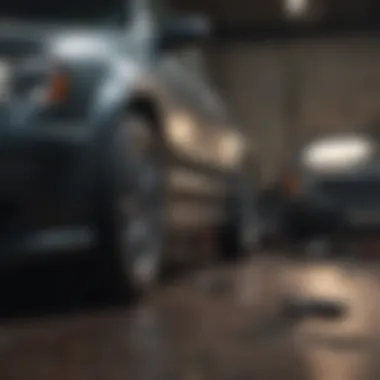Understanding Vehicle Body Work Costs: A Comprehensive Guide


Intro
When it comes to car ownership, understanding the costs associated with body work is crucial. Body work refers to repairs made to a vehicle’s exterior, which may arise from accidents, wear and tear, or environmental factors. These repairs can be unexpected, leading to significant financial strain if not properly managed.
In this article, we will cover various aspects influencing the costs of body work, including the types of repairs typically involved, the average costs you can expect, and the factors that influence pricing. We will also look at regional variations in pricing, the implications for insurance coverage, and practical tips for minimizing out-of-pocket expenses. Our goal is to provide vehicle owners with the knowledge needed to make informed decisions about automotive repairs.
Prelims to Body Work
Body work is a crucial aspect of automotive repair that focuses on restoring a vehicle's exterior. Understanding the costs associated with body work is essential for vehicle owners who may face repairs due to accidents or wear and tear. Body work not only enhances the appearance of a car but also protects it from further damage, potentially increasing its resale value. A clear grasp of this subject helps car owners make informed choices.
Definition of Body Work
Body work refers to the repair and restoration of a vehicle's exterior components. This includes the metal paneling, frame structure, and any related features like bumpers and lights. When a car undergoes an incident such as a collision, it is likely to suffer from dents, scratches, or more severe structural damage. The primary goal of body work is to bring a vehicle back to its original condition, ensuring both aesthetics and safety.
Common Types of Body Work
Several types of body work are frequently performed on cars. These include:
- Dent Repair: This involves fixing minor dents and dings without the need for paint. Techniques may include paintless dent repair, which is less invasive and preserves the vehicle's original finish.
- Scratch Repair: Surface scratches can occur easily and can be rectified through buffing or repainting. The approach taken often depends on the depth of the scratch.
- Panel Replacement: In cases of significant damage, entire panels such as doors or fenders may need replacement. This is often a more complex process requiring specialized skills.
- Frame Straightening: When the vehicle's frame is bent, frame straightening is necessary. This requires special equipment to restore the frame's structural integrity.
"Understanding body work is important for maintaining the value and integrity of your vehicle."
In summary, body work represents a critical investment for vehicle owners. Knowing what it entails and the common types can help in assessing options for repair and cost expectations.
Factors Affecting Body Work Costs
Understanding the costs associated with body work on vehicles is crucial for car owners. The factors influencing these costs can vary widely based on several key elements. Knowledge about these factors helps vehicle owners anticipate expenses, make better decisions, and minimize surprises during the repair process. Here, we delve into the specific variables that impact the overall cost of body work, providing a comprehensive view for the discerning vehicle owner.
Extent of Damage
The extent of damage to a vehicle significantly dictates repair costs. Minor damage, such as small dents or scratches, usually requires less labor and materials, resulting in lower expenses. For example, superficial scratches can often be polished out or repaired using simple spot painting techniques. Meanwhile, severe damage, like a crushed fender or extensive collision damage, necessitates more comprehensive repairs. This can include replacing parts or even structural realignment. The more severe the issue, the higher the labor service charge and material needed, leading to a longer repair duration and elevated costs.
Vehicle Make and Model
Another variable influencing body work costs is the make and model of the vehicle. Luxury vehicles like BMW or Mercedes-Benz often have unique parts and specialized service requirements. Because of this, repairs on these types of cars are generally more expensive than those for more common brands, like Honda or Toyota. The availability of parts also comes into play; if a car requires specific or rare components, sourcing these parts might incur additional charges. Vehicle complexity often dictates costs because some models may have advanced technologies or specific design features that require specialized knowledge to repair.
Type of Repair Required
The type of repair required can greatly affect overall costs. For instance, cosmetic repairs, such as repainting a damaged area, usually come at a different price point compared to structural repairs. Structural repairs — which can involve frame straightening or replacements — are typically more labor-intensive and therefore more costly.
Additionally, repairs that require advanced techniques or extensive labor, like body panel replacement or collision damage repair, would generally demand higher costs due to complexity.
"Understanding the type of repair can help estimate the financial implications before authorizing work."
Average Cost Range for Common Repairs
Understanding the average cost range for common bodywork repairs is essential for car owners. Knowledge of the costs can help in budgeting and making informed decisions about vehicle maintenance. This section breaks down the cost implications of minor, moderate, and severe repairs. It provides a clear view of not only what to expect but also factors to keep in mind when considering repairs. Each repair category has its unique characteristics that significantly influence pricing.
Minor Repair Costs


Minor repairs typically involve cosmetic issues or small dents that do not affect the vehicle's overall function. Examples include:
- Dents and Scratches: Small dents and paint scratches can often be repaired without extensive work and usually cost between $50 to $150. These repairs are relatively straightforward and can sometimes be handled by a mobile technician.
- Bumper Scuffs: Minor damage to bumpers can be buffed out or painted over. The costs for these types of repairs usually range from $100 to $300, depending on the extent of the scuff.
- Windshield Chips: Small chips or cracks in the windshield can often be filled for around $50 to $100, which is economical compared to a full replacement, which can exceed $300.
These costs reflect not just the materials involved, but also the labor required for quick fixes. Understanding these costs helps vehicle owners assess when a repair might be worth pursuing versus ignoring.
Moderate Repair Costs
Moderate repairs are often necessary when there is more notable damage. These may include:
- Panel Replacement: When a door or fender is damaged, it may require complete panel replacement. Costs can range from $500 to $1,500, depending on the part and labor involved.
- Paint Jobs: A full or partial paint job for a panel or section of the car can cost between $300 to $700. Quality of paint and expertise of the shop affect this price.
- Alignment Issues: If bodywork involves the alignment of parts or frame issues, costs can vary, falling within the range of $200 to $500 depending on the severity.
Investing in moderate repairs can preserve the car's value. A willing approach can prevent minor damage from escalating into severe problems later.
Severe Repair Costs
Severe repairs can have considerable financial implications and often indicate significant damage. Common scenarios include:
- Accident Damage Repair: Repairing damages from an accident can vary widely, often ranging from $1,500 to $5,000 or more, depending on the nature of the damage and parts involved.
- Frame Repair: If the vehicle's frame is bent, the repair costs generally land between $2,000 and $10,000. This is complex work requiring specialized equipment and expertise.
- Replacement of Major Components: Items like engines or transmissions that have suffered damage may need substantial repairs, costing anywhere from $3,000 to $7,000, depending on parts and labor.
Severe repairs can impact a vehicle's function and safety. Therefore, prompt assessment and action can be critical.
"Understanding the cost ranges for repairs can not only save money but also significantly impact the lifespan and value of a vehicle."
In summary, being aware of the average costs for various types of bodywork repairs enhances car owner capabilities in managing their vehicle's health effectively.
Regional Price Variations
Cost Differences by Region
Costs for body work can greatly fluctuate from one region to another. For example, urban areas often experience higher prices due to increased demand and the associated cost of living. In contrast, rural regions may offer more competitive rates, as the demand for body work services might be lower.
Several key elements influence these cost differences:
- Labor Rates: In cities like New York or Los Angeles, labor rates for body repairs can be significantly higher compared to smaller towns.
- Supplier Proximity: Regions closer to suppliers may have lower parts costs, impacting overall repair prices.
- Market Demand: High demand in metropolitan areas can drive up costs as multiple consumers vie for services.
It is prudent for vehicle owners to research local repair shops to get a clearer idea of typical costs in their area.
Impact of Local Market Conditions
Local market conditions can also have a profound effect on body work pricing. Economic factors such as local unemployment rates, competition between repair shops, and even seasonal changes can influence pricing. For instance, during busy seasons, like after major holidays or severe weather events, repair shops may increase their prices due to higher demand. Conversely, during slower months, there may be promotions or discounts offered to attract customers.
Additionally, the presence of large chains versus independent shops makes a difference. Chain repair shops often have fixed pricing structures that can lead to consistent pricing, while independents may vary their prices based on operation costs and local demand. This can provide an opportunity for negotiation, particularly in a competitive market.
Generally, aware consumers can leverage knowledge about local market conditions to seek out the best deals while maintaining quality service.
Insurance Considerations
Insurance plays a crucial role in the financial aspect of body work costs. Understanding the nuances of coverage can significantly affect how much you end up paying out-of-pocket. Many vehicle owners underestimate their insurance policies and how they interact with repair costs. Proper knowledge can lead not only to savings but also to a smoother claims process when damage occurs.


Understanding Coverage Options
Every insurance policy is different, often influenced by the provider and individual circumstances. Most vehicle owners typically have several types of coverage, including liability, collision, and comprehensive insurance.
- Liability Insurance: Covers damages you may cause to others’ property but does not cover your own car.
- Collision Insurance: This is where body work costs often get coverage; it helps pay for repairs to your vehicle after an accident, regardless of who is at fault.
- Comprehensive Insurance: Offers protection against events that are not collision-related, such as theft, vandalism, or natural disasters.
Choosing the right combination of coverage is essential. It is advisable to regularly review your options, as repairs can be costly and having comprehensive protection can alleviate financial stress following an incident.
Filing Claims for Body Work
Filing a claim can sometimes be daunting, yet it is vital for recovering repair costs. A well-prepared claim will typically involve several steps:
- Document the Damage: Capture clear photographs and gather details regarding the incident. This information helps to support your claim.
- Contact Your Insurer: Notify your insurance provider as soon as possible. Many companies require that you report damage within a set timeframe.
- Follow Up: Stay in regular contact with the insurer to ensure that the claim is processed efficiently.
Being organized and proactive can sometimes enhance your claim outcome. Insurers often look for evidence of timely reporting and clear documentation.
Deductibles and Out-of-Pocket Expenses
Understanding deductibles is critical because it determines how much you will pay before your insurance kicks in. A deductible is the agreed amount you must pay out-of-pocket before the insurer covers the rest. For example, if the car body work costs $2,000 and your deductible is $500, you will need to pay that $500.
It is also important to understand that certain repairs may not be fully covered under your policy. This can lead to unexpected expenses. Here are a few considerations regarding deductibles and out-of-pocket costs:
- Higher Deductible, Lower Premium: Choosing a higher deductible can lower your monthly premium, but it might lead to greater costs in the event of repairs.
- Assessing Value of Coverage: Rethink how you value insurance coverage based on your vehicle's age and the likelihood of damage. Sometimes, paying a higher premium for a lower deductible is a wiser financial strategy.
"Understanding your insurance policy can make a substantial difference in how you budget for potential repairs."
Considering all these elements, knowing how to navigate insurance can empower vehicle owners. Whether it’s annual premiums or out-of-pocket expenses, educated choices can yield significant savings over time.
Choosing a Repair Shop
Choosing a repair shop is a critical step in addressing body work needs for your vehicle. With numerous options available, the selection process can greatly influence the quality of repairs and the ultimate cost. An informed choice can lead to well-executed repairs, ensuring not only aesthetic appeal but also vehicle safety.
In this section, we will explore specific strategies for assessing repair shops, obtaining quotes, and evaluating warranties. By understanding these elements, vehicle owners can approach the repair process with confidence, minimize potential costs, and make educated choices that fulfill their automotive requirements.
Assessing Repair Shops
When it comes to selecting a repair shop, several factors should be considered to ensure quality service. A good reputation is crucial. Look for shops that have strong reviews and ratings on platforms like Yelp or Google. Customer feedback often reveals the honesty, expertise, and professionalism of the shop.
Moreover, verify the shop's certifications. Certifications from organizations such as the National Institute for Automotive Service Excellence (ASE) indicate that the shop has met specific standards in automotive repair. It's also prudent to check if the shop has experience with your vehicle type, especially if it is a foreign or luxury model.
Ask about the shop's warranty policies as well. A reliable repair shop will stand by their work, offering warranties that cover parts and labor for a reasonable duration. This not only shows confidence in their service but protects your investment in case issues arise post-repair.
Getting Quotes
Obtaining quotes is an essential part of the repair process. This practice allows vehicle owners to compare costs and services among different shops. When requesting estimates, ensure that the quotes are detailed. They should include a breakdown of labor costs, parts, and any additional fees.
It is advisable to gather quotes from at least three different shops. This approach not only provides a clearer picture of the market rates but also helps identify any shops that may overcharge. Be cautious of quotes that seem too low, as they may indicate subpar materials or rushed work.
Once you receive quotes, also inquire about the estimated time for repair completion. Understanding the timeline is important for planning purposes, especially if you rely on your vehicle for daily use.


Evaluating Warranties Offered
Warranties can serve as an important safety net for car repairs. When discussing repairs with a shop, ask specifically about the warranties they offer. A solid warranty will typically cover both parts and labor for a certain period, ensuring that any new issues related to the original repair will be addressed without extra costs.
Evaluate the length and scope of these warranties. Some shops may offer limited warranties which cover only specific parts or a short time period, while others provide comprehensive coverage. Furthermore, it's important to read the warranty specifics, as conditions may apply. For example, some warranties may be voided if the vehicle is subjected to improper use or maintenance.
In summary, the choices made when selecting a repair shop can greatly affect both the immediate cost and long-term satisfaction with the body work. Assessing repair shops carefully, getting thorough quotes, and understanding warranties can all contribute to a more satisfactory repair experience.
Cost-Saving Strategies
Cost-saving strategies are crucial for any vehicle owner considering body work. Repairs can quickly accumulate costs, making it essential to understand how to minimize expenses without compromising quality. Effective strategies can help in making informed decisions, ensuring vehicle longevity, and keeping costs manageable.
Preventative Maintenance
Preventative maintenance is the best strategy to avoid costly body work later on. Regular inspections and timely repairs can detect issues before they turn into significant problems. For example, keeping the paint sealed can prevent rust, which is both unsightly and expensive to repair. Schedule maintenance checks regularly and follow your vehicle's manual recommendations.
Key benefits of preventative maintenance include:
- Extended vehicle lifespan
- Improved safety
- Enhanced resale value
In practice, preventative care might involve simple actions such as washing your car after winter to remove road salt or applying wax every few months. Keep track of services and repairs in a log to maintain awareness of what is needed next.
Utilizing Discounts and Promotions
Many automotive repair shops offer discounts and promotions to attract customers. Being aware of these can save substantial amounts of money on body work. Some shops may provide seasonal deals, while others offer loyalty programs or discounts for first-time customers. Be proactive and look for advertisements as well as online coupons.
- Types of discounts to consider:
- Seasonal promotions
- Referral programs
- Military or student discounts
"You can often find valuable discounts through your community or online forums like Reddit or local Facebook groups."
Additionally, consider joining automotive clubs or associations. Members often receive special offers from partnered repair shops. Always inquire about possible discounts when seeking quotes.
Negotiating Repair Costs
Negotiating repair costs may seem intimidating, but it is a valuable skill that can lead to savings. Being prepared with information gives you an advantage. Research the average costs for the specific repairs your vehicle needs. When you have clear data, you can discuss pricing with repair shops.
- Tips for negotiating:
- Gather multiple quotes from different shops
- Ask about itemized pricing
- Do not hesitate to question charges
- Be polite yet assertive
Being informed and clear about what you need can lead to a more successful negotiation. Always remember that many mechanics value customer trust and satisfaction. Thus, they may be open to adjusting prices or offering additional services if they think it will keep you coming back.
Epilogue
Understanding the costs associated with body work on a car is crucial for any vehicle owner or business operator. Body work involves a wide range of repairs and restorations that directly influence the overall longevity and appearance of a vehicle. Recognizing the complexities of pricing can help owners make more informed choices.
Recap of Key Points
In this article, various factors that affect body work costs have been discussed. Key points include:
- The extent of damage plays a significant role in determining repair costs.
- Specific make and model impact pricing, as some vehicles are more expensive to repair than others.
- Different types of repairs, from minor to severe, carry distinct average costs.
- Understanding regional price variations helps in anticipating local market conditions.
- Insurance considerations can significantly affect out-of-pocket expenses and overall cost management.
- Strategies for cost-saving, such as preventative maintenance and utilizing discounts, empower owners to better manage expenses.
Final Thoughts on Body Work Costs
Navigating the costs of body work requires not only an understanding of the explicit expenses involved but also awareness of the inherent value of maintaining a vehicle's integrity. Each repair, whether minor or extensive, contributes to the vehicle's safety and aesthetics. Vehicle owners should weigh their options carefully, inquire about estimates, and prioritize transparent communication with repair shops.



